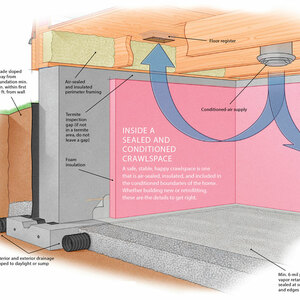I’m putting in a heating mat below tile while renovating my master bathroom. The old floor is a 1/2″ waferboard-like product over 3 1/2 inch planks. From the archives, it seems best to use self-leveling compound poured over a heating mat instead of thin set, so I was thinking of removing the waferboard where I want the heat, and setting the mat on the planks, and pouring the self-leveling compound over the mat. Is that too thick?
Jeff


















Replies
Len,
Thanks for the reply.
Actually, I had already pulled up the 'waferboard' around the toilet due to water damage and was going to replace that area with plywood...so I might as well pull the rest up.
So now I thought about 3/4 plywood in most areas but only using only 1/2 (or 5/8) plywood where the mat would be, so I could still 'recess' the mat and have a 1/4 (or 1/8) dam for the compound. However, it seems like most manufacturers (NuHeat, Warmfloor, Thermotile and Suntouch) say to use their product over the cement board (though I read somewhere WarmFloor could be done either way). That means the cement board would have to be trimmed to fit into the recess (below the mat and leveling compound) and would result in the plywood and cement board 'edges' being on top of each other. Maybe that's ok since the leveling compound would fill the gaps....but wouldn't that still be the point where cracks would start?
Thanks again.
Jeff
Remove the waferboard and glue/screw down hardieboards., then your mat and SLC
subfloor
Len,
The 1937 3 1/2" pine boards (not tongue and groove) rest diagonally on a mix of 1937 and 1960 2x6 joists (the '37 are a true 2x6); spaced anywhere between 14 in and 16 inches. The joists themselves span approx 10' and rest on what looks like 4 x 7 (not 4 x 8).
Jeff
I'd rethink it a bit...
Ove the planking, you need "something" before adding anything cementitious, you can't do SLC over planking, nor can you apply cement board right over the planking, or tile right over planking. At least not IAW the manufacturer's instructions.
Your best bet for this would be 1/2" ply or something equivalent over the planking. That'll give you a proper starting point.
From there...SLC can go directly over plywood but you'll usually need a mesh or lathe type of materialand a primer for the SLC, then the SLC. SLC can go right over cement board without the mesh/lathe material and primer. As to SLC with the heating mat, it really depends on which SLC and which heating mat. I add that because some mats are "mesh" mats, some are "solid" woven blankets. Too many configurations.
Your generic best bet would be 1/2" ply or equivalent over the plank subfloor. Then for your desire to recess things, you could do 1/4" cement board where you want the mat to go and 1/2" cement board where the heating mat will not go. Thinset the cement board to the plywood and fasten with screws or nails. Add the mat and SLC in the recessed area.
If the bathroom isn't very large, why not just SLC the whole thing: 1/2" ply over the planking, then 1/4" cement board thinsetted and screwed/nailed to the ply. Add your heating mat. Caulk and dam as needed to contain the SLC. Then SLC the entire floor.
If the thickness of cement board will be a factor, you can SLC over the plywood. But as written earlier, you'll need primer and a mesh or lathe material for the SLC. In this case you'd still do 1/2" ply over the wood planking, then the lathe/mesh, set your heating mat, dam/caulk as needed to contain the SLC. Then the SLC primer, and the SLC.
So there are different ways that need different materials, and to a certain extend, different skill sets. Nothing here is outlandish skill-wise, but have all your ducks in a row if doing SLC. It waits for no one.
One thing to understand though, is that "nothing cement" can go directly over wood planking.
Best, Mongo
When we did our (smallish) upstairs bath about 20 years ago, the shop recommended stapling down expanded metal mesh over the existing 3/4" fiberboard sheathing, then skimming that with thinset. (This was before cement board for floors was commonly used.) According to them it was much stiffer than any other option -- the other option was to add another 1/2" plywood.
Worked well, though I did have to take extra care to get the floor flat.
Floor heat
Just replace the plywood with new plywood or cement board then pour the self leveling cement over everything. It's not as hard as it sounds and way easier than trying to recess into plywood.
Good luck